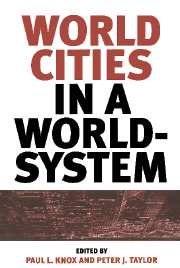Book contents
- Frontmatter
- Contents
- List of contributors
- Preface
- Part 1 Introduction: world city, hypothesis and context
- Part 2 Cities in systems
- Part 3 Politics and policy in world cities: theory and practice
- 12 Re-presenting world cities: cultural theory/social practice
- 13 Theorizing the global–local connection
- 14 The disappearance of world cities and the globalization of local politics
- 15 World cities and global communities: the municipal foreign policy movement and new roles for cities
- 16 The environmental problematic in world cities
- 17 The successful management and administration of world cities: mission impossible?
- Appendix The world city hypothesis
- Index
13 - Theorizing the global–local connection
Published online by Cambridge University Press: 07 October 2009
- Frontmatter
- Contents
- List of contributors
- Preface
- Part 1 Introduction: world city, hypothesis and context
- Part 2 Cities in systems
- Part 3 Politics and policy in world cities: theory and practice
- 12 Re-presenting world cities: cultural theory/social practice
- 13 Theorizing the global–local connection
- 14 The disappearance of world cities and the globalization of local politics
- 15 World cities and global communities: the municipal foreign policy movement and new roles for cities
- 16 The environmental problematic in world cities
- 17 The successful management and administration of world cities: mission impossible?
- Appendix The world city hypothesis
- Index
Summary
In their seminal article (1982) John Friedmann and Goetz Wolff encouraged us to explore how the integration of cities in the world economy is ‘reflected’ in the ‘character of their urbanizing processes’, specifically, how people live within these cities. The central issue, they maintained, was whether resident populations, transnational corporations, or the ‘nation states that provide the political setting for world urbanization’ would control urban life (Friedmann and Wolff 1982: 309).
This framing of theoretical tasks suggests that our attention should be turned not only outward to world-city hierarchies but also inward to the ‘duality’ of contemporary world cities (Castells and Mollenkopf 1991; Marcuse 1989; Schurmann and Close 1979). The issue is the extent to which social, economic, and political relations and processes within cities — that is, at the urban scale — are influenced by forces operating at a global scale. This is a quite different concern to asking how world cities are constituted within global hierarchies and subsequently organize the world (or at least most of it) for capital accumulation (Friedmann 1986, see appendix to this volume).
Over the last two decades numerous theorists have addressed the relation between the global and the local. Their ruminations appear under various rubrics: locality studies (Cooke 1989; Lancaster Regionalism Group 1985); global cities (Alger 1990; Fainstein, Gordon, and Harloe 1992; Rodriguez and Feagin 1986; Sassen 1991); economic restructuring (Beauregard 1989a; Henderson and Castells 1987; Scott and Storper 1986; Smith and Feagin 1987); and world development (Kennedy 1993; Peet 1991).
- Type
- Chapter
- Information
- World Cities in a World-System , pp. 232 - 248Publisher: Cambridge University PressPrint publication year: 1995
- 46
- Cited by

